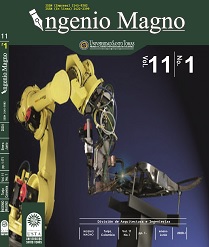Wearable technology a competitive advantage in sports training
Main Article Content
Abstract
Downloads
Article Details
DECLARATION OF ORGINIALITY OF SUBMITTED ARTICLE
With this document, I/We certify that the article submitted for possible publication in the institutional journal INGENIO MAGNO of the Research Center Alberto Magno CIIAM of the University Santo Tomás, Tunja campus, is entirely of my(our) own writing, and is a product of my(our) direct intellectual contribution to knowledge.
All data and references to completed publications are duly identified with their respective bibliographical entries and in the citations thus highlighted. If any adjustment or correction is needed, I(we) will contact the journal authorities in advance.
Due to that stated above, I(we) declare that the entirety of the submitted material is in accordance with applicable laws regarding intellectual and industrial property, and therefore, I(we) hold myself(ourselves) responsible for any complaint related to it.
If the submitted article is published, I(we) declare that I(we) fully relinquish publishing rights of the article to the University Santo Tomás, Tunja campus. As remuneration for this relinquishment of rights, I(we) declare my(our) agreement to receive two (2) copies of the edition of the journal in which my(our) article appears.
References
Publidex: https://scienti.minciencias.gov.co/publindex/#/revistasPublindex/buscador
SCOPUS: https://www.scopus.com/home.uri
SCIMAGO: https://www.scimagojr.com/journalrank.php?category=2204&area=2200&year=2018
Web of Science https://url2.cl/EVzdq
Steve Mann, Hal Niedzviecki (Nov 2001), Cyborg: Digital Destiny and Human Possibility in the Age of the Wearable Computer.
Simancas González, E. y Moreno Mateo-Sidrón, N. M. (2017): Estudio prospectivo en spaña: la tecnología wearable en el ámbito empresarial. Posibilidades como herramienta de comunicación, Icono 14, volumen 15 (2), pp. 220-243. doi: 10.7195/ ri14.v15i2.108.
wearables, D. (2014). Dispositivos wearables. Obtenido de http://www.dispositivoswearables.net.
Zamorano, E. (29 de agosto de 2013). FayerWayer. Obtenido de El largo camino de la computación vestible para llegar a las masas: https://www.fayerwayer.com/2013/08/ellargo-camino-de-la-c omputacion-vestiblepara-llegar-a-las-masas/
Mobile Robot Using an Adaptable Fuzzy Control on a Digital Signal Processor, BAÁvila - 2006 - Tesis de Maestría Universidad Nacional de Colombia.
Bernal Suárez, W., & Fagua Fagua, A. (2015). Prototipo adquisición y filtrado digital de señales para fonocardiografía. Ciencia, Innovación y Tecnología, Volumen 2, pg 17-2.
Alfonso-Mora, Margareth Lorena; Ávila- Barón, Adolfo, Cambios cinemáticos de la marcha en pacientes con artrosis de rodilla con diferentes descargas de peso, Revista Ciencias de la Salud, vol. 12, núm. 3, -, 2014, pp. 319-329, Universidad del Rosario Bogotá, Colombia.
Chía SL, Hormaza, M, Vélez C, Vidarte J, (2012). Determinantes sociales de la salud y discapacidad, Tunja 2012. Artículo de investigación. Archivos de medicina. Volumen 14-1 pg. 51-63.
MR. Reina, SLC Chía, DM Ávila, Automatización residencial un desafío profesional para el monitoreo de personas en condición de discapacidad visual, Ingenio Magno 10-2, pg 50-64.

